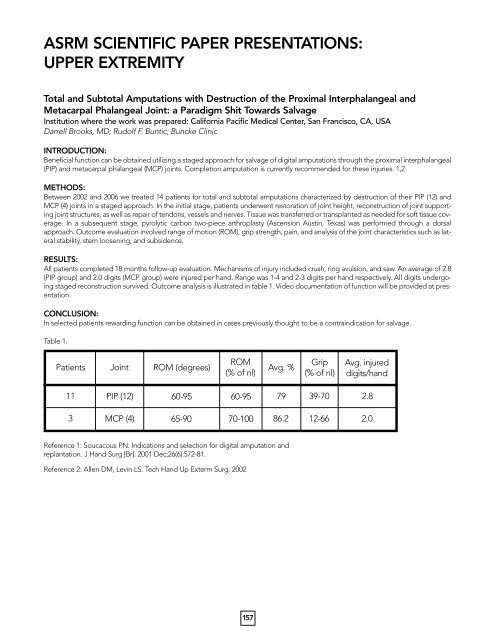Floor plan - 2013 Annual Meeting - American Association for Hand ...
Floor plan - 2013 Annual Meeting - American Association for Hand ...
Floor plan - 2013 Annual Meeting - American Association for Hand ...
Create successful ePaper yourself
Turn your PDF publications into a flip-book with our unique Google optimized e-Paper software.
ASRM SCIENTIFIC PAPER PRESENTATIONS:<br />
UPPER EXTREMITY<br />
Total and Subtotal Amputations with Destruction of the Proximal Interphalangeal and<br />
Metacarpal Phalangeal Joint: a Paradigm Shit Towards Salvage<br />
Institution where the work was prepared: Cali<strong>for</strong>nia Pacific Medical Center, San Francisco, CA, USA<br />
Darrell Brooks, MD; Rudolf F. Buntic; Buncke Clinic<br />
INTRODUCTION:<br />
Beneficial function can be obtained utilizing a staged approach <strong>for</strong> salvage of digital amputations through the proximal interphalangeal<br />
(PIP) and metacarpal phalangeal (MCP) joints. Completion amputation is currently recommended <strong>for</strong> these injuries. 1,2<br />
METHODS:<br />
Between 2002 and 2006 we treated 14 patients <strong>for</strong> total and subtotal amputations characterized by destruction of their PIP (12) and<br />
MCP (4) joints in a staged approach. In the initial stage, patients underwent restoration of joint height, reconstruction of joint supporting<br />
joint structures, as well as repair of tendons, vessels and nerves. Tissue was transferred or trans<strong>plan</strong>ted as needed <strong>for</strong> soft tissue coverage.<br />
In a subsequent stage, pyrolytic carbon two-piece arthroplasty (Ascension Austin, Texas) was per<strong>for</strong>med through a dorsal<br />
approach. Outcome evaluation involved range of motion (ROM), grip strength, pain, and analysis of the joint characteristics such as lateral<br />
stability, stem loosening, and subsidence.<br />
RESULTS:<br />
All patients completed 18 months follow-up evaluation. Mechanisms of injury included crush, ring avulsion, and saw. An average of 2.8<br />
(PIP group) and 2.0 digits (MCP group) were injured per hand. Range was 1-4 and 2-3 digits per hand respectively. All digits undergoing<br />
staged reconstruction survived. Outcome analysis is illustrated in table 1. Video documentation of function will be provided at presentation.<br />
CONCLUSION:<br />
In selected patients rewarding function can be obtained in cases previously thought to be a contraindication <strong>for</strong> salvage.<br />
Table 1.<br />
Patients Joint ROM (degrees)<br />
11<br />
3<br />
PIP (12)<br />
MCP (4)<br />
60-95<br />
65-90<br />
ROM<br />
(% of nl)<br />
60-95<br />
70-100<br />
157<br />
Avg. %<br />
Reference 1: Soucacous PN. Indications and selection <strong>for</strong> digital amputation and<br />
re<strong>plan</strong>tation. J <strong>Hand</strong> Surg [Br]. 2001 Dec;26(6):572-81.<br />
Reference 2: Allen DM, Levin LS. Tech <strong>Hand</strong> Up Exterm Surg. 2002<br />
79<br />
86.2<br />
Grip<br />
(% of nl)<br />
39-70<br />
12-66<br />
Avg. injured<br />
digits/hand<br />
2.8<br />
2.0



